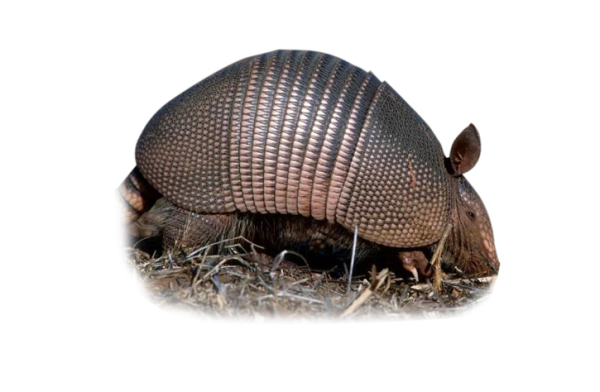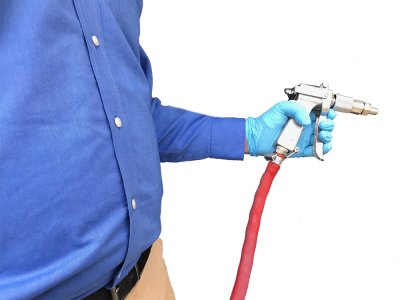
Armadillos
Scientific Name: Cingulata
The name Armadillo is Spanish and means “little armored one”. They are related to anteaters and sloths. All species of armadillos are native to the Americas, where they inhabit a variety of widely varying environments.
Lifespan: 7-10 years
Description
Armadillos have a leathery armour shell and long sharp claws for digging. They have short legs, but in spite of that can move very quickly. The average length of an armadillo is about 30 in including tail. The giant armadillo grows up to 5 feet long and weighs up to 119 lbs. When threatened by a predator, many species of armadillos roll up into a ball.
Armadillos are small to medium-sized mammals. The smallest species, the pink fairy armadillo, is roughly chipmunk-sized weighing in at 3 ounces and only 5- inches in length. The largest species, the giant armadillo, can be the size of a small pig and weigh up to 119 lb and can be almost 6 feet long.
Where Do Armadillos Live?
Armadillos originated in South America. Armadillos were confined to South America for most of the Cenozoic era. When the Isthmus of Panama formed, it allowed a few members of the family to migrate into southern North America by the early Pleistocene.
The nine-banded armadillo prefers to build burrows in moist soil near the creeks, streams, and arroyos around which it lives and feeds.
Today, all armadillo species are still present in South America. They are particularly numerous and diverse in Paraguay where 11 species exist. Many species of armadillos are endangered.
Two species, the northern naked-tailed armadillo and nine-banded armadillo, are found in Central America; the nine banded armadillo has also reached the United States, mostly in the south but they can be found as far east as North Carolina and Florida, and as far north as southern Nebraska and southern Indiana. Because armadillos have no natural predators in North America, their range continues to increase every year.
Diet
Armadillos eat mostly insects, with over 90% of their diet consisting of animal matter, like insects and other invertebrates. They’re also known to eat the occasional reptile or amphibian – especially in colder weather. The remainder of their diet consists of plant matter, although it’s been found that most of the vegetation they eat has been consumed as they feed on their primary food. Many species use their sharp claws to dig for food, such as grubs, and to dig dens. The diets of different armadillo species vary, but consist mainly of insects, grubs, and other invertebrates. Some species, however, feed almost entirely on ants and termites. Favorite foods of the armadillo include: beetles, termites, worms, grasshoppers, insect larvae,maggots, snails and ants.
Reproduction
Females of some species have delayed fertilisation, in which sperm is stored in the reproductive tract for several months after mating. Mating occurs in the autumn but fertilisation does not occur until the following spring. Other species exhibit delayed implantation, in which the egg is fertilised after mating, but remains free in the reproductive tract until external conditions become favourable for giving birth and caring for the offspring.
After implantation, the zygote splits into four genetically identical embryos, which gestate inside the mother for four months. Each develops its own placenta, helping to ensure that all four babies survive pregnancy and make it into the world. Once born, the four baby armadillos stay with the mother for six to eight months before venturing out into the world. A single female armadillo can produce up to 56 babies, in groups of four, during the course of her lifetime.
Disease
Armadillos are often used in the study of leprosy, since they are among the few known species that can contract the disease systemically. They are particularly susceptible due to their unusually low body temperature, which is hospitable to the leprosy bacterium, Mycobacterium leprae. Humans can acquire a leprosy infection from armadillos by handling them or consuming armadillo meat.
Identifying Armadillo Damage
Most armadillo damage comes about as a result of their digging habits, taking the forms of holes and burrows.
- Signs of armadillo damage include:
holes throughout lawn, about 3-5″ wide and 1-3″ deep - uprooted plants and seedlings
- burrow entrances, about 7-10″ in diameter, next to or underneath structures,
sidewalks, brush piles, low-lying shrubs, etc. - damaged underground wires or pipes
- cracked foundation or concrete sidewalk/driveway
- armadillo tracks: four toes in front with elongated center two toes; five toes in back
with elongated center three toes; all claws visible.
How to Trap Armadillos
Armadillos can be trapped using steel cage traps. The trap must be a professional model because armadillos are so strong that they will destroy traps that are not strongly reinforced.
Armadillos are tough to catch. You will need patience and a willingness to change trap layout patterns until you catch your problem armadillo. The best bet is to go with an established animal control company. A good wildlife company will not exterminate armadillos but instead trap and release them in a remote area.
(706) 221-8000
REQUEST A QUOTE

100% Satisfaction
There is a reason our work is guaranteed…we do it right. If you would ever have a problem with pests while we are in charge of your pest control, we will work until the problem is resolved. Our contracts provide you with quarterly service and we will take care of any problems that may happen to arise between visits.
We Guarantee It!

Request Free Pest Inspection
EMERGENCY SERVICE AVAIALBLE
Request Free Pest Inspection
EMERGENCY SERVICE AVAIALBLE

